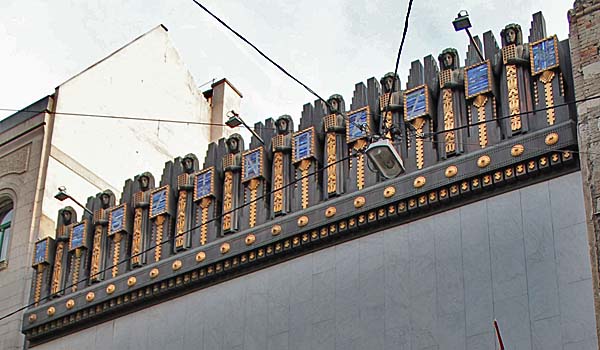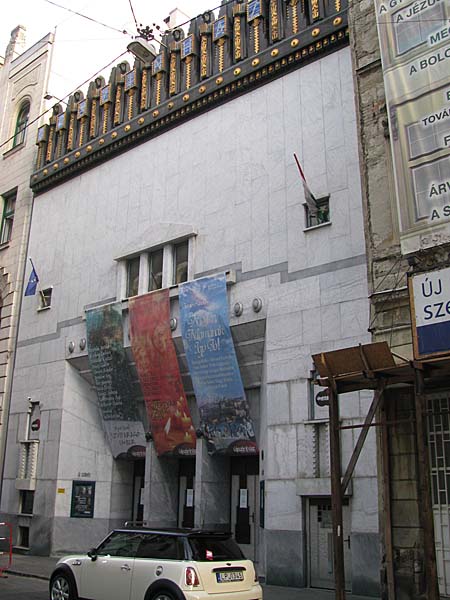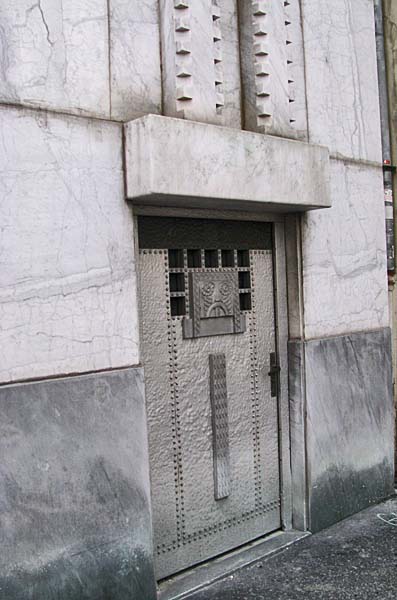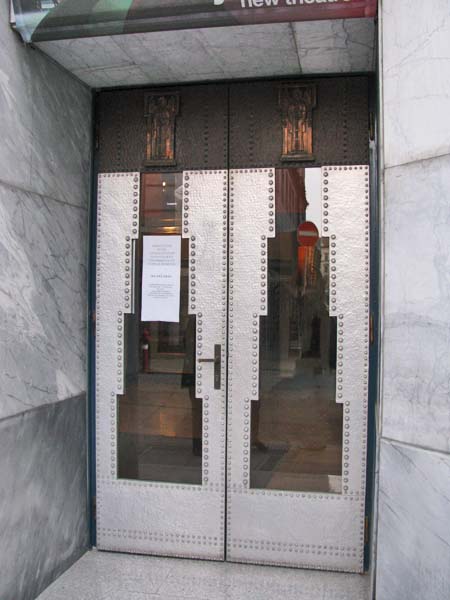| Architect |
Béla Lajta (1909), László Vágó (1921), Konig and Wagner Architects – Tamás Konig, Péter Wagner (1987-1990) |
| Date Built |
Original
1909 - reconstructed 1990 |
| Location |
Paulay Ede
str. 35. |
| Description |
|
| Paulay Ede str is a relatively
quiet street one block away from
Budapest's bustling Andrassy Way.
The Opera House is not far away.
Tucked away on this quiet street is this
gem of a theatre building know at the
moment as the New Theatre. I say at
the moment because it has undergone
several names changes over the 103 years
of its history. It opened in 1909 as the Parisiana Nightclub designed by the Hungarian architect Béla Lajta. An entry in the book "Jewish Budapest: Memories, Rites History" by Kinga Frojimovics and Géza Komoroczy describes it as, " ... a well-planned nightclub on the relatively small plot. In front of the building there was a small room with a separate entrance from a separate staircase. The main entrance opened into a foyer with a gallery. The main hall itself was an especially gaudy room: high ceiling, trapezoid-shaped, huge marble surfaces with gold, layered rims. Against the back wall there were some boxes and a tiny stage in the front." The Parisiana was converted into a theatre in 1921 to a design by Laslo Vago. It was called the Blaha Lujza Theatre. "Two extra floors of balconies were added in the main hall and the angular forms were replaced by the Neo-Empire style." According to Frojimovics and Komoroczy further name changes followed including Kristalypalota “Crystal Palace” or Tancpalota “Dance Palace” In the 50s and 60s changes to the exterior of the building apparently ruined the facade but in 1991 the Municipality restored the original facade and created a, " ... nicely structured foyer, but kept the theatre as designed by Vago." The facade is clad in Carrara marble and the doors are covered with aluminium. At the roof level a series of metallic winged muses stand among the crenelations, that feature a cobalt-blue mosaic sign that spells-out “SZÍNHÁZ” or “theater” in Hungarian.  The New Theatre has been the centre of controversy in recent times following the surprise dismissal of its artistic director by Budapest's mayor and his replacement by the actor György Dörner. The decision sparked a strongly negative reaction in Hungary and around the theatre world. A letter to the Guardian in the UK, dated January 26, 2012, signed by notable people including the Artistic directors Michael Attenborough and Michael Boyd, and the actors Antony Sher, Imelda Staunton, Dan Stevens, Janet Suzman, Harriet Walter, Zoë Wanamaker, Samuel West and Timothy West, said that, "We are alarmed by the imposition of a far-right director on one of Budapest's leading theatres, and call on our foreign secretary and the international community to put pressure on the Hungarian government to reverse the decision before 1 February, the day the theatre is scheduled to change hands. Following the election of the rightwing Fidesz party, the mayor of Budapest sacked the director of Új Színház (the New Theatre), and appointed actor György Dörner in his place. Dörner supports the anti-Roma, anti-gay and antisemitic party Jobbik. .......... Currently, the New Theatre presents both Hungarian plays and the international canon, from Schiller to Shakespeare. Dörner plans to reverse what he describes as a "degenerate, sick, liberal hegemony" in Hungary by stopping the production of "foreign garbage" and concentrating on Hungarian plays. These include the work of his friend and adviser István Csurka, an open antisemite, advocate of the Jewish conspiracy theory, and president of the Hungarian Justice and Life party. Several Hungarian writers have withdrawn their plays from the theatre in protest." |
|
|
The New
Theatre, Budapest, Hungary
   Close Window  |